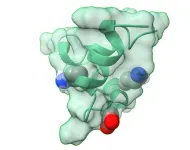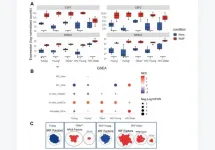(Press-News.org) Although the COVID-19 pandemic was the first time most of humanity learned of the now infamous disease, the family of coronaviruses was first identified in the mid-1960s. In a new study, molecular biologist Steven Van Doren, a scientist in the University of Missouri College of Agriculture, Food and Natural Resources, has uncovered unexpected actions of a key player in how the coronavirus infects its target — a discovery that could guide further vaccine development.
Funded by a National Science Foundation (NSF) grant, Van Doren and his team studied the fusion peptide, an important feature of the spike protein that serves to bind the virus with the human cell, an essential step in the course of infection. In this study, they found that the fusion peptide plays a more invasive role in fusing the virus to the cell than previously thought, which is significant in understanding how infection occurs.
“The fusion peptide is the most preserved part of the whole viral spike,” said Van Doren, a professor of biochemistry. “Throughout the evolution of this virus, the fusion peptide endured despite all the mutations and variants that we kept on hearing about in the news. The fusion peptide never changed much and stayed a constant feature on the virus spike because it’s too critically important for infection for it to be modified.”
The fusion peptide on the SARS-CoV-2 spike (pictured here) plays a key role in virus/cell attachment.
This research is interesting to compare to a recent study that surveyed asymptomatic patients who were infected by the coronavirus because they had developed a defense mechanism known as broadly neutralizing antibodies. Van Doren’s research on the functionality of the fusion peptide’s ability to puncture a cell membrane could further inform why the fusion peptide may be an important target for vaccine development capable of fighting all types of coronavirus infections.
Another potential application of this research could be to create a novel strategy to penetrate cells.
“There may be many strategies for crossing membranes, but it's conceivable that the fusion peptide work could help further development of more ways to cross cellular membranes, which could be useful to deliver therapeutics through cell membranes,” Van Doren said.
Further, this research broadens understanding of protein insertion in membranes, which has broader relevance to the scientific community.
“I love what protein molecules look like and what they can do,” Van Doren said. “I got fascinated by the science when I was still a teenager, and it's intriguing to me the things they can do, so studying how proteins work has been something that has stuck with me for decades now — I’d say going on almost 40 years.”
The study “SARS-CoV-2 Fusion Peptide Sculpting of a Membrane with Insertion of Charged and Polar Groups” was published in Structure. Co-investigators include Benjamin S. Scott and Rama K. Koppisetti.
END
Mapping the coronavirus spike protein could provide insight into vaccine development
In a new study, University of Missouri biochemist Steven Van Doren examines the properties of a key part of the SARS-CoV-2 spike protein to understand how infection occurs.
2023-08-31
ELSE PRESS RELEASES FROM THIS DATE:
Dectin-1 stimulation promotes distinct inflammatory signature in HIV and aging
2023-08-31
“To our knowledge, our study is the first to evaluate the specific function of Dectin-1 in the setting of aging and HIV-infection.”
BUFFALO, NY- August 31, 2023 – A new research paper was published on the cover of Aging (listed by MEDLINE/PubMed as "Aging (Albany NY)" and "Aging-US" by Web of Science) Volume 15, Issue 16, entitled, “Dectin-1 stimulation promotes a distinct inflammatory signature in the setting of HIV-infection and aging.”
Dectin-1 is an innate immune receptor that recognizes and binds β-1, 3/1, 6 glucans on fungi. In this new study, researchers Archit Kumar, Jiawei Wang, Allen Esterly, Chris ...
Excess ceramide and disrupted iron metabolism in neuronal mitochondria found to be the cause for MEPAN syndrome
2023-08-31
A recent study published in Nature Metabolism has revealed the pathogenic mechanism underlying a rare pediatric neurodegenerative disorder known as mitochondrial enoyl reductase protein-associated neurodegeneration (MEPAN) syndrome. The study was led by Dr. Hugo J. Bellen, distinguished service professor at Baylor College of Medicine, and Chair of Neurogenetics at the Jan and Dan Duncan Neurological Research Institute at Texas Children’s Hospital (Duncan NRI), and Dr. Debdeep Dutta, a postdoctoral fellow in the Bellen lab. The Duncan NRI team found that in patients and animal models of this disorder, a large number of neurons ...
A new approach to stop cancer growth?
2023-08-31
CLEVELAND– Case Western Reserve University biochemical researchers have identified a new function of a key protein that leads to cancer–a finding they believe could lead to more effective treatments for a range of cancers and other diseases.
The protein is LSD1 (lysine-specific histone demethylase 1A), which functions as a type of traffic cop inside human cells. It controls gene activity during embryonic development and regulating gene expression throughout life.
Scientists have also identified in recent years that the overexpression of LSD1—in this instance, producing too many proteins—can ...
Study: ‘Suicidal’ mechanism discovered in ion channel receptors enables the sensing of heat and pain
2023-08-31
BUFFALO, N.Y. – The ability to accurately detect heat and pain is critical to human survival, but scientists have struggled to understand on a molecular level exactly how our bodies sense these potential risks.
Now, University at Buffalo researchers have unraveled the complex biological phenomena that drive these critical functions. Their research, published in the Proceedings of the National Academy of Sciences on Aug. 28, has uncovered a previously unknown and completely unexpected “suicidal” reaction in ion channel receptors that explains the complicated mechanisms that underlie sensitivity to temperature and pain.
The ...
Scientists unpick how lung cells induce immune response to influenza
2023-08-31
Researchers from Trinity College Dublin have discovered some new and surprising ways that viral RNA and influenza virus are detected by human lung cells, which has potential implications for treating people affected by such viruses.
Influenza viruses remain a major threat to human health and can cause severe symptoms in young, elderly, and immuno-compromised populations, leading to annual epidemics which endanger between 3 and 5 million people of severe illness and cause 290,000 to 650,000 deaths worldwide.
These viruses primarily target respiratory epithelial cells ...
Expanding the impact of CAR T cell therapy: An immunotherapy strategy against all blood cancers
2023-08-31
PHILADELPHIA – A broad new strategy could hold hope for treating virtually all blood cancers with CAR T cell therapy, which is currently approved for five subtypes of blood cancer. Scientists in the Perelman School of Medicine at the University of Pennsylvania have demonstrated the potential efficacy of this approach in preclinical tests.
In the study, published today in Science Translational Medicine, the researchers used engineered CAR T cells to target CD45—a surface marker found on nearly all blood cells, including nearly all blood cancer cells. Because CD45 is found on healthy blood cells too, the research team used CRISPR base-editing to develop a method ...
New project to make data curation accessible
2023-08-31
JooYoung Seo, assistant professor in the School of Information Sciences at the University of Illinois Urbana-Champaign, has been awarded a $649,921 Early Career Development grant from the Institute of Museum and Library Services (IMLS grant RE-254891-OLS-23), under the Laura Bush 21st Century Librarian Program, which supports “developing a diverse workforce of librarians to better meet the changing learning and information needs of the American public by enhancing the training and professional development of librarians, developing faculty and library leaders, and recruiting and ...
A step closer to digitizing the sense of smell: Monell Center, Osmo model describes odors better than human panelists
2023-08-31
PHILADELPHIA (August 31, 2023) – A main crux of neuroscience is learning how our senses translate light into sight, sound into hearing, food into taste, and texture into touch. Smell is where these sensory relationships get more complex and perplexing.
To address this question, a research team co-led by the Monell Chemical Senses Center and start-up Osmo, a Cambridge, Mass.-based company spun out of machine learning research done at Google Research, Google DeepMind (formerly known as Google Brain), are investigating how airborne chemicals connect to odor perception in the brain. To this end they discovered that a machine-learning ...
New odor map helps match perceptions of smells with their chemical structure
2023-08-31
Brian K. Lee and colleagues have developed a Principal Odor Map (POM) that models the connections between an odorant’s chemical structure with its perceptual property of smell. The map performed as well as some highly trained human “sniffers” in describing odor quality, and could be used for predicting odor intensity and perceptual similarity between odorants. The map moves researchers closer to being able to match molecular properties of odorants to their perceptual properties, a challenge that has proved difficult for olfactory science. (For other senses, neuroscientists have been able to map light wavelengths ...
Early ancestral bottleneck could’ve spelled the end for modern humans
2023-08-31
How a new method of inferring ancient population size revealed a severe bottleneck in the human population which almost wiped out the chance for humanity as we know it today.
An unexplained gap in the African/Eurasian fossil record may now be explained thanks to a team of researchers from China, Italy and the United States. Using a novel method called FitCoal (fast infinitesimal time coalescent process), the researchers were able to accurately determine demographic inferences by using modern-day human genomic sequences from 3,154 individuals. These findings indicate that early human ancestors went through a prolonged, severe bottleneck in which approximately 1,280 ...
LAST 30 PRESS RELEASES:
Tracing the quick synthesis of an industrially important catalyst
New software sheds light on cancer’s hidden genetic networks
UT Health San Antonio awarded $3 million in CPRIT grants to bolster cancer research and prevention efforts in South Texas
Third symposium spotlights global challenge of new contaminants in China’s fight against pollution
From straw to soil harmony: International team reveals how biochar supercharges carbon-smart farming
Myeloma: How AI is redrawing the map of cancer care
Manhattan E. Charurat, Ph.D., MHS invested as the Homer and Martha Gudelsky Distinguished Professor in Medicine at the University of Maryland School of Medicine
Insilico Medicine’s Pharma.AI Q4 Winter Launch Recap: Revolutionizing drug discovery with cutting-edge AI innovations, accelerating the path to pharmaceutical superintelligence
Nanoplastics have diet-dependent impacts on digestive system health
Brain neuron death occurs throughout life and increases with age, a natural human protein drug may halt neuron death in Alzheimer’s disease
SPIE and CLP announce the recipients of the 2025 Advanced Photonics Young Innovator Award
Lessons from the Caldor Fire’s Christmas Valley ‘Miracle’
Ant societies rose by trading individual protection for collective power
Research reveals how ancient viral DNA shapes early embryonic development
A molecular gatekeeper that controls protein synthesis
New ‘cloaking device’ concept to shield sensitive tech from magnetic fields
Researchers show impact of mountain building and climate change on alpine biodiversity
Study models the transition from Neanderthals to modern humans in Europe
University of Phoenix College of Doctoral Studies releases white paper on AI-driven skilling to reduce burnout and restore worker autonomy
AIs fail at the game of visual “telephone”
The levers for a sustainable food system
Potential changes in US homelessness by ending federal support for housing first programs
Vulnerability of large language models to prompt injection when providing medical advice
Researchers develop new system for high-energy-density, long-life, multi-electron transfer bromine-based flow batteries
Ending federal support for housing first programs could increase U.S. homelessness by 5% in one year, new JAMA study finds
New research uncovers molecular ‘safety switch’ shielding cancers from immune attack
Bacteria resisting viral infection can still sink carbon to ocean floor
Younger biological age may increase depression risk in older women during COVID-19
Bharat Innovates 2026 National Basecamp Showcases India’s Most Promising Deep-Tech Ventures
Here’s what determines whether your income level rises or falls
[Press-News.org] Mapping the coronavirus spike protein could provide insight into vaccine developmentIn a new study, University of Missouri biochemist Steven Van Doren examines the properties of a key part of the SARS-CoV-2 spike protein to understand how infection occurs.




